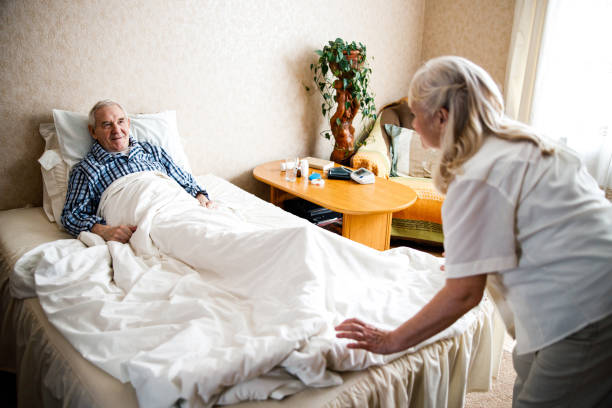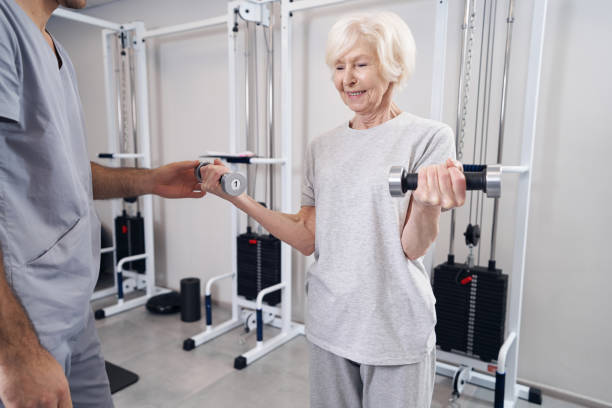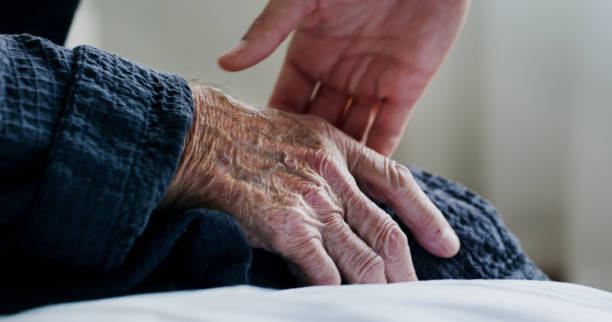Introduction

Living with Parkinson's Disease can be a difficult journey, but there are ways to help those affected maintain their independence and quality of life. Moving in bed is an activity that can be done independently, even for those with mobility issues.
In this blog post, we will discuss how to maximize independence for Parkinson's patients who need help moving in bed. We will look at the importance of mobility, tips on how to move in bed, and helpful products that can make it easier.
Techniques and Tips for safe movement for Parkinson's Patients in Bed
There are 15 million people worldwide living with Parkinson's Disease, and while each person experiences a unique set of challenges, they all face difficulty when it comes to moving in bed. As an advocate for those living with PD, you can help maximize their independence by helping them learn how to move safely and comfortably in bed. Here are some tips:
1. Encourage slow
Encouraging slow, controlled bed mobility is essential when managing Parkinson's disease. Moving slowly and consciously helps prevent falls and injuries by allowing the patient to adjust as necessary during movement. It also helps reduce stress on the joints and muscles, giving people with PD more access to their range of motion. Encourage patients to take their time when transferring from one position to the next, and encourage them to use both hands and feet or other assistive devices for greater stability.
The bed should also be free of clutter, with minimal sheets and blankets. This allows patients more freedom of movement and lessens the risk of tripping or losing their balance. The bed should also be a comfortable height, and the mattress should be supportive yet soft. Encourage using pillows, wedges, and other positioning aids to support and allow for comfortable movements. Additionally, the use of friction-reducing sheets and sleepwear can significantly improve bed mobility and independence.
2. Building strength
Building core strength is important for those living with Parkinson's disease. Encourage activities such as pelvic tilts, bridges, and leg extensions to help them maintain good posture in bed. This exercise strengthens the legs and back muscles, enabling patients to move more easily in bed while reducing their risk of falls or injuries. Additionally, gentle stretching and range-of-motion exercises can help maintain flexibility so patients can better move in bed without feeling stiff.
Finally, creating a safe environment for those living with PD is important. Encourage safety rails on the sides of the bed for extra support and ensure that pathways leading from the bed are clear and clutter-free. Patients can move in and out of their beds with greater confidence and independence.
3. Professional assistance
Professional assistance may sometimes be necessary to help a Parkinson's patient move safely in bed. A certified physical therapist or occupational therapist can provide an individualized plan of care tailored to the patient's needs and teach them how to use assistive devices and adaptive equipment. Additionally, they can offer advice on proper body mechanics and ergonomics to promote safe bed mobility.
Patients must also speak when they need help, whether from a caregiver or medical professional. Open communication is essential for creating an environment of comfort when moving in bed, so make sure your patient feels comfortable asking for assistance when needed.
4. Self-care
Reiterate the importance of self-care and good hygiene regarding bed mobility. Encourage patients to keep their skin clean and dry, and provide them with products such as long-handled sponges or wipes to help them maintain a hygienic environment while in bed.
Additionally, promote all positions besides lying down when sleeping, as this helps reduce the risk of bedsores or skin ulcers. Encourage using mobility-enhancing/ friction reducing sheets and sleepwear, a low air loss mattress and positioning devices such as wedges to provide better support, help improve comfort, and increase independence.
With these tips in mind, you can empower those with Parkinson's disease to move safely and independently in bed. By providing the right environment, tools, and support, you can help them maintain their independence and dignity while promoting overall well-being.
10 Ways to Help Someone You Love Manage Parkinson's Disease
The physical toll of Parkinson's Disease can be challenging to manage. It's important to have strategies to help you or someone you love cope with the disease. Here are ten tips for helping maximize independence for a person living with Parkinson's:
1. Establish an exercise routine

Exercise has been proven to help Parkinson's patients improve strength, mobility, and balance. Encourage the person to join a local exercise program or start low-impact activities at home like walking, stretching, or yoga.
2. Provide emotional support
Living with any chronic disease can be stressful and emotional for everyone involved. Offer encouragement and understanding to help the patient stay positive and motivated.
3. Invest in adaptive equipment
Assistive devices like walkers, grab bars, shower benches, and wheelchair ramps can help make daily life easier for someone with Parkinson's by allowing them to be more independent.
4. Make modifications to the home
Simple changes such as installing extra stair rails, widening doorways, and adding non-slip mats in the bathroom can help make the home safer for someone with Parkinson's.
5. Know the signs of a 'freezing' episode
Freezing episodes can occur when a person with Parkinson's stops moving abruptly while walking or standing. Knowing how to respond during this episode can help keep everyone safe.
6. Track symptoms
Keeping a journal of the person's symptoms and medications can help you and your loved one recognize patterns, which may help manage and control Parkinson's Disease.
7. Incorporate healthy eating habits
Eating a balanced diet is essential for managing any chronic disease. Incorporate foods like fruits and vegetables, whole grains, lean proteins, and low-fat dairy to help maintain energy levels and overall health.
8. Get plenty of rest
People with Parkinson's need adequate daily rest to conserve energy for physical activities and manage symptoms.
9. Maximize independence while in bed
Use friction-reducing mobility-enhancing sheets and sleepwear for increased independence. Positioning pillows and wedges, securely around the person, can help them stay comfortably in bed while they move throughout the night. This will also help to prevent pain or discomfort that could lead to an injury.
10. Seek help when needed
Many resources are available for people with Parkinson's and their caregivers to help them manage the disease. Consider consulting a doctor or physical therapist specializing in movement problems disorders if needed.
These strategies can help maximize independence for someone with Parkinson's disease while providing emotional support and comfort. With the right tools, you can ensure that your loved one can maintain their quality of life.
What is a positive coping mechanism for Parkinson's disease?

A positive coping mechanism for Parkinson's disease is to maximize independence when moving in bed. This includes developing proactive strategies that will help improve mobility, strength, and balance while minimizing fatigue and falls. Some techniques include:
-
Using pillows or cushions strategically to provide support as you move around in bed
-
Placing assistive devices such as grab bars, trapezes, sliding boards, or specialized bed tables within easy reach
-
Utilizing sets of friction-reducing sheets and sleepwear to help get into and out of bed
-
Learning proper body mechanics when moving in bed can help conserve energy
-
Total contact casting may be used to reduce joint contractures
-
Performing daily exercises and stretches to maintain joint range-of-motion
-
Rely on caregivers or family members when needed
How do you promote independence in Parkinson's disease?
Promoting patient independence is an important part of providing quality healthcare. There are several strategies that healthcare providers can use to help their patients become more independent.
One way to promote patient independence is by providing education and training on self-care techniques. One way to help patients is by demonstrating correct medication dosage instructions, emphasizing the significance of sufficient sleep, healthy eating, and physical activity, or providing instructions on using supportive equipment such as walkers or wheelchairs. It is also important to give patients appropriate instructions on using the equipment safely so they can confidently perform their daily activities.
Another way to promote patient independence is by giving the patient an active role in their care. This might include encouraging them to participate in decision-making, providing feedback on treatment plans, and offering support when needed. It is also important to involve family members and caregivers so that they can provide additional guidance and assistance as needed.
Finally, healthcare providers should strive to create an environment that encourages independence and patient autonomy. This might include providing a safe space for patients to express their thoughts and feelings without feeling judged, offering enough information on treatment options to make informed decisions, and giving them the freedom to choose their care.
By promoting patient independence, healthcare providers can ensure their patients receive the best care possible. With knowledge and support from healthcare professionals, patients can become more independent and empowered to make the best decisions for their health.
What are the benefits of helping a Parkinson's patient be as independent as possible?
Here are some benefits of helping a Parkinson's patient become as independent as possible:
1. Improved Quality of Life: Independence allows people with Parkinson's to have more autonomy, which can improve their overall quality of life and well-being. With the help of family members and caregivers, those living with Parkinson's can maintain their independence for longer and participate in activities that may otherwise have been lost.
2. Reduced Stress: Independence can reduce stress for the patient and their caregivers by allowing them to feel empowered and capable of managing their care needs. Caregivers can also focus more on specific tasks rather than managing various needs simultaneously.
3. Enhanced Safety: Independence can help ensure Parkinson's patients stay safe by removing the risk of falls and other potential environmental hazards. By having access to resources that enable them to manage their care needs, they can better take necessary safety measures and monitor their overall health and well-being.
4. Improved Mental Health: Independence allows Parkinson's patients to participate in activities that help them stay engaged and connect with others, which can benefit their mental health. By maintaining control of their care needs and staying involved in activities they enjoy, Parkinson's patients will be more likely to maintain an optimistic attitude and preserve their sense of purpose in life.
Ultimately, helping a Parkinson's patient become as independent as possible can lead to improved quality of life, reduced stress, enhanced safety, and improved mental health. With the right resources and support, those living with Parkinson's can maintain their independence for longer and have access to the care they need to stay safe and healthy.
FAQ's
What should I do if a Parkinson's patient resists help when moving in bed?
If a Parkinson's patient resists help when moving in bed, it is important to approach the situation with empathy and understanding. Start by talking with them and expressing your concerns for their safety. Ensure they understand that you are trying to help them maintain their independence and provide the care they need to stay safe.
Can family and caregivers help Parkinson's patients move in bed?
Family members and caregivers can help Parkinson's patients move in bed. It is important to consider caregivers’ safety as they perform manual repositioning which can take its toll on backs, shoulders, wrists and more. Friction reducing sheets and sleepwear sets relieve much of this strain and risk of musculoskeletal injury. Providing guidance and support when needed while respecting their wishes is crucial. Involving family members and caregivers ensures the patient receives additional help while also helping to maintain independence.
What are the two main goals for the patient with Parkinson's disease?
The two main goals for a patient with Parkinson's disease are to maintain independence and safety. Healthcare providers, family members, and caregivers can help Parkinson's patients achieve these goals by providing emotional support, access to resources, and assistance with daily tasks as needed.
What is self-management of Parkinson's?
Self-management of Parkinson's is a term used to describe a person's ability to manage their own care needs. This includes understanding the common symptoms and side effects associated with Parkinson's and taking steps to manage them effectively. Self-management can help patients remain independent for longer while also reducing stress levels and enhancing safety. Self-management also helps to improve mental health and well-being, as it allows Parkinson's patients to stay engaged in activities that they enjoy.
Conclusion
In conclusion, helping Parkinson's patients maintain independence is key to their health and well-being. By understanding how to maximize independence for Parkinson's patients moving into bed, healthcare providers, family members, and caregivers can help ensure that the patient receives the care they need while preserving their autonomy. With access to resources, support, and guidance, those living with Parkinson's can maintain their independence for longer and have access to the care they need to stay safe and healthy.

